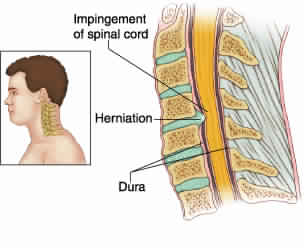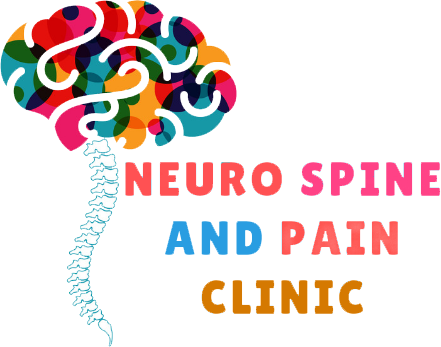
Cervical
Neck pain and chakkar are the most common symptoms with which a patient present s in a neuro OPD with a self made diagnosis of CERVICAL. In our population 90% people have it at some time in life. Chakkar is not usually due to cervical.
Muscle strains: Due to overuse and poor posture, like long driving posture, prolonged use of, mobile phones or reading in stooped posture in bed.
Worn Joints: Joints in neck undergo wear and tear
Nerve compression: Disc herniation or bone osteophyte formation in neck vertebrae can press on the nerves leading to pain.
Whiplash injuries: Head is jerked backward and forward
Systemic Diseases: Arthritis, tuberculosis, Cancer pain, ankylosing spondylosis and fibromyalgia
Symptoms
- Dull aching pain, worsened with neck movement. It is sometimes associated with tingling, numbness or tenderness of upper limbs. There may be difficulty in swallowing or dizziness/ light-headedness.
- This pain may be associated with facial pain, headache or shoulder pain.
Types of pain
Acute neck pain: At Home patient may apply heating pads or ice packs as counter pain relievers.
Chronic neck pain: If pain is prolonged over days and weeks a pain specialist needs to be consulted. The exact cause of pain needs to be ascertained and treated after investigations.
Diagnosis
A working diagnosis is reached after thorough history and physical examination of the patient. The detailed history and pain scores are analysed and a battery of tests are adviced as per requirement. The tests may range from simple blood tests CBC, KFT, LFT, X rays, MRI, Algometry, EEG , NCV, VEP, to BERA.
Physical therapy: Ultrasonic, short wave diathermy, laser and controlled traction. Along with these neck strengthening exercises are performed.
– Pharmacotherapy: This includes a combination of nerve medicines, safe pain killers, muscle relaxants and other drugs which are given depending on the exact cause of pain.
– Interventional therapy: If a combination of physical and pharmacotherapy is unable to provide adequate pain relief then we should go for interventional (injection) pain management techniques such as cervical epidural and trigger point injections. These techniques are absolutely safe, effective and produce rapid recovery in all age groups provided they are performed by the experts (pain physicians).
– Life style modifications: These are required for prevention of further such events. These include avoiding lifting heavy weights, long uninterrupted work hours in front of laptop, using mobile phones for long periods and use of pillows. Develop good postures while sitting, working, reading, driving etc.
– Surgical options: Surgery is rarely required. There are specific indications for surgery.
Cervical disc disease may be the most common cause of neck pain. It’s caused by an abnormality in one or more discs, the cushions that lie between the neck bones (vertebrae). When a disc is damaged, usually due to wear or tear (degeneration) or to disc herniation, it can lead to neck pain from inflammation or muscle spasms. In severe cases, pain and numbness can occur in the arms from nerve irritation or damage from pinching a nerve.
While pain relievers, physical therapy, neck traction, and as a last resort, surgery, can help ease neck pain from cervical disc disease, there are also home remedies you can use to help relieve pain and speed the healing process.
Neck Pain Tip 1: Take It Easy
If you’re like most people, you probably live a busy, hectic life. But if you’re living with cervical disc disease and have increased neck pain, it’s important to temporarily ease back on intense activities. While you are resting, find a comfortable position — one that causes you the least amount of neck pain. You can place a rolled up towel or a pillow under your neck to help keep your neck in a neutral position. Resting doesn’t mean crawling into bed and remaining perfectly still, however. Staying immobile for more than a day or two actually can be harmful because it can decondition the muscles that support your neck and actually increase neck pain in the long run. While your neck is healing, adjust your activity level to what you can comfortably handle. As you improve, gradually increase your activity level back to normal.
Neck Pain Tip 2: Apply Cold/Heat
People often face the hot/cold conundrum: Which one should you use? Generally, the recommendation is to use ice for the first 24 to 48 hours after an injury to reduce swelling, followed by heat to loosen muscles and improve stiffness. But with cervical disc disease, neither heat nor cold is going to penetrate deeply enough to actually relieve the inflammation, so use whichever feels best. Regardless of whether you choose cold or heat, keep it on for only about 20 minutes at a time and then leave it off for at least 40 minutes. Wrap the ice or heat source in a towel — never put it directly against your skin or you could wind up with a nasty burn.
Neck Pain Tip 3: Stretch
Once you are feeling well enough and your doctor gives permission, practice stretching exercises to both relieve neck pain and improve your flexibility.
It’s best to perform these exercises after warming up muscles with a warm shower, bath, or towel.
Here are a few simple stretches for cervical disc disease that you can do at home:
- Slowly turn your head to the left. With your left hand, apply very light tension on your chin so that your head turns slightly more. Hold for 20 seconds and return your head slowly to center. Repeat on the right side.
- Tilt your head to the left and try to touch your left ear to your shoulder. With your left hand, apply light pressure on your temple. Hold for 20 seconds and repeat on the right side.
- Bend your head forward and try to touch your chin to your chest. Relax the shoulders as you do this. Hold for 20 seconds and repeat.
- Lie on your back with your knees bent and a pillow under your head and neck for support. Nod your head forward gently, as though you were saying “yes.” Hold the position for 10 seconds and then relax. Repeat 10 times.
- If you feel significant discomfort with any of these stretches, stop immediately.
Neck Pain Tip 4: Move It
Research is showing that exercise is an effective way to treat neck pain. According to a study in the Journal of the American Medical Association, women with chronic neck pain who performed strength and endurance exercises using resistance bands and light weights significantly reduced their neck pain and disability. It’s also important to keep active in general. Thirty minutes of aerobic exercise (walking, biking, swimming) every day can keep your back muscles strong. And improved blood flow from exercise can nourish your spine help to keep it healthy. Talk to your doctor, physical therapist, or a personal trainer with expertise in working with people with neck pain to determine the right exercises for you.
Neck Pain Tip 5: Get Out of Your Slump
Bad posture is a major contributor to neck pain. Think about your posture every time you are sitting, standing, or lifting. Always try to keep your head and neck straight and make sure your back is supported. When you sit at your desk, for example, your computer should be at eye level and your chair should be right up against your back (in other words, don’t press your nose against the computer screen). Your mouse should be positioned low enough so that you don’t have to continually reach for it. When you go to pick something up, don’t lean forward. Instead, bend from your knees and keep your back straight, which will also help protect against low back pain.
Vertigo ( Chakkar) is a feeling of dizziness and spinning, occurring with or without any movement. Usually, vertigo is a symptom of an underlying medical condition or several different conditions. It reoccurs until the underlying cause is treated.
Simple facts on Vertigo: It is Not due to Cervical Spine Disease
Symptoms can last anywhere from a few minutes to a few hours and may come and go.
Treatment for vertigo will depend on the cause.
Medication can relieve symptoms of dizziness, nausea, and motion sickness.
Symptoms
Vertigo may cause headaches, nausea, sweating, double vision, lack of coordination or changes in hearing.
What are the causes?
It is not the cervical spine which is deemed culprit by most people but the most common cause is BPPV. Also, BPPV recurs 50 percent of the time, according to a 2014 report published in the journal Advances in Otolaryngology.
The inner ear is responsible for the body’s sense of balance. In BPPV there are changes in the fluid movement of the inner ear which is sensed abnormally by the brain causing dizziness and a spinning sensation for a short time.
Other causes of vertigo are:
The common cold, which causes inner ear inflammation. This type of vertigo usually resolves within a few days.
Vestibular Neuritis: VN is a condition affecting the vestibule-cochlear nerve, this nerve is responsible for carrying balance and head-positioning signals to brain. When the nerve is inflamed, the brain misinterprets balance and head positioning
Meniere’s disease: Meniere’s is a condition that causes severe vertigo and affects hearing in one ear. Patients complains of ringing in the ears and a feeling of “fullness” in the ear
Head or Neck Injury: Vertigo is a common symptom that can follow a head or neck injury. This is due to temporary
Stroke: Due to lack of blood supply to certain parts of the brain. Stroke causes dizziness and imbalance rather than just one.
.
.Treatment
Most of the time, vertigo resolves without treatment, as the brain can compensate for changes to the inner ear to restore someone’s balance.
Medications, such as steroids, can reduce inner ear inflammation, and water pills can reduce fluid buildup.
For people who have recurrent episodes of vertigo, a physical therapy called vestibular rehabilitation can help. Vestibular rehabilitation encourages the central nervous system to compensate for inner ear problems.
Home remedies for vertigo
Vertigo can be managed naturally with a variety of home remedies.
Epley maneuver
Sitting on the edge of a bed and turning the head 45 degrees to the left
lying down quickly and facing head up on the bed at a 45-degree angle
maintaining the position for 30 minutes
turning the head halfway — 90 degrees — to the right without raising it for 30 seconds
turning the head and entire body to the right side, looking downward for 30 seconds
slowly sitting up but remaining sitting for at least a few minutes
If vertigo starts on the right side in the right ear, these directions should be done in reverse.
Ginkgo Biloba
Ginkgo biloba is a Chinese herb known for resolving the symptoms of vertigo. It works by managing blood flow to the brain to relieve dizziness and balance issues.
Ginger Tea: A ginger root can be steeped in a cup of boiling water for 5 minutes. Honey can help with the bitter taste. Drinking ginger tea twice a day may help dizziness, nausea, and other vertigo symptoms.
Almonds
Almonds are rich sources of vitamins A, B, and E. Eating a daily handful of almonds can help with vertigo symptoms.
How almonds help is unknown, but it is possible the vitamin content can comb
the causes of vertigo.
Staying hydrated
Dehydration can cause symptoms of vertigo. Even mild dehydration can trigger the condition.
Staying hydrated can help minimize dizziness and balance issues.
When to see a doctor
Anyone who has reoccurrences of vertigo should see their doctor.
